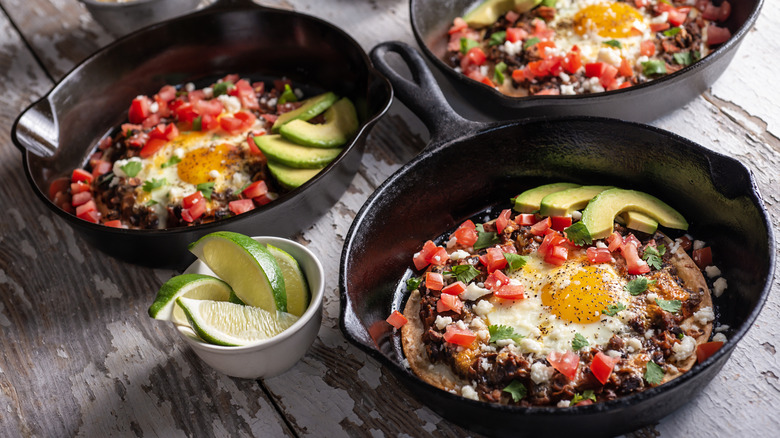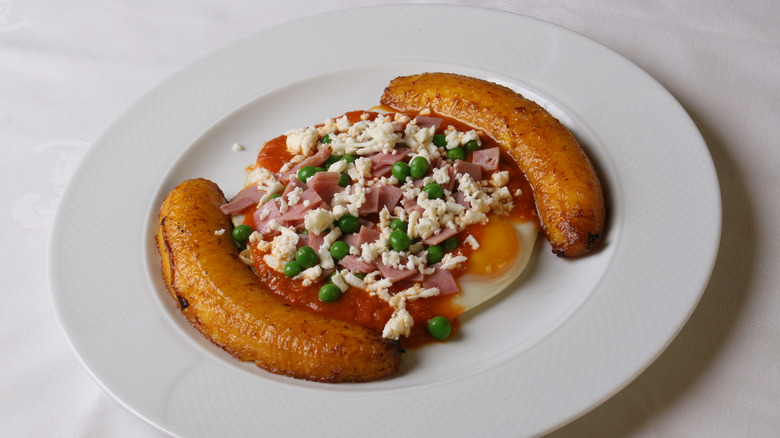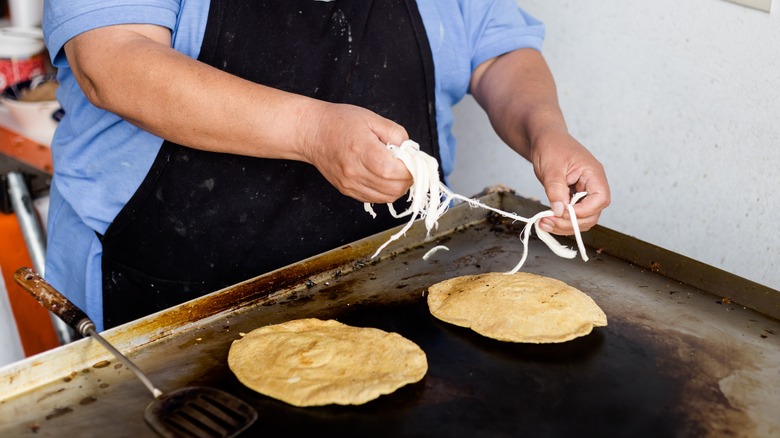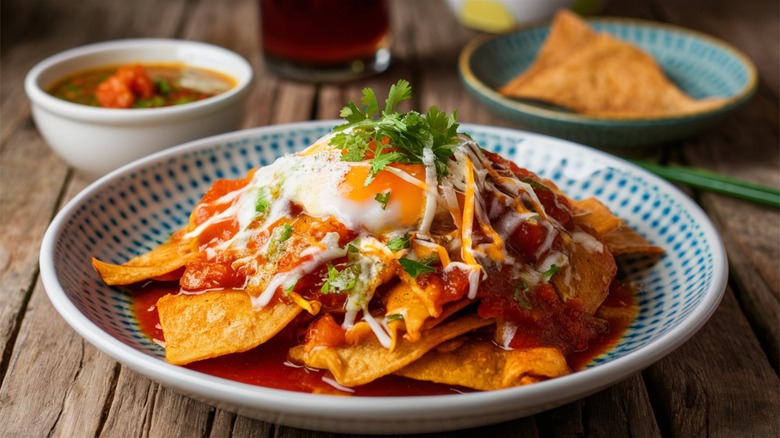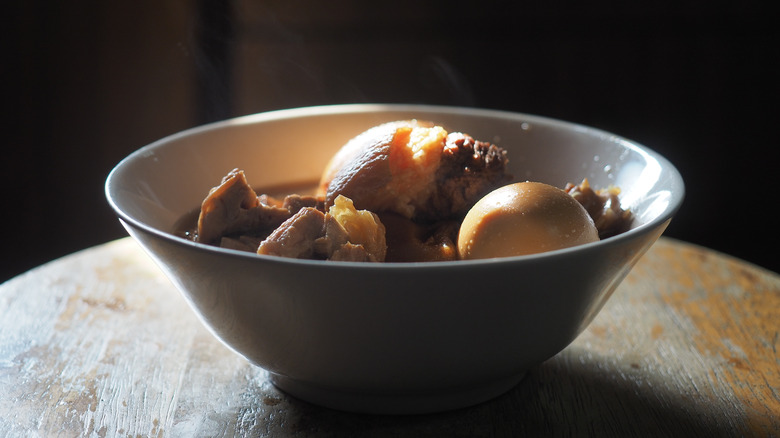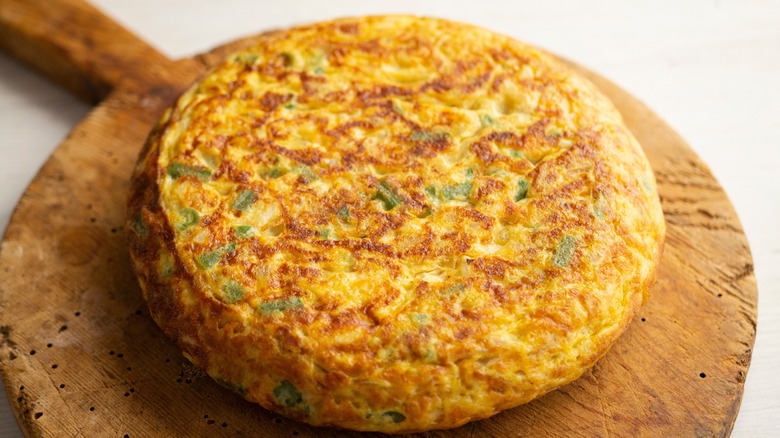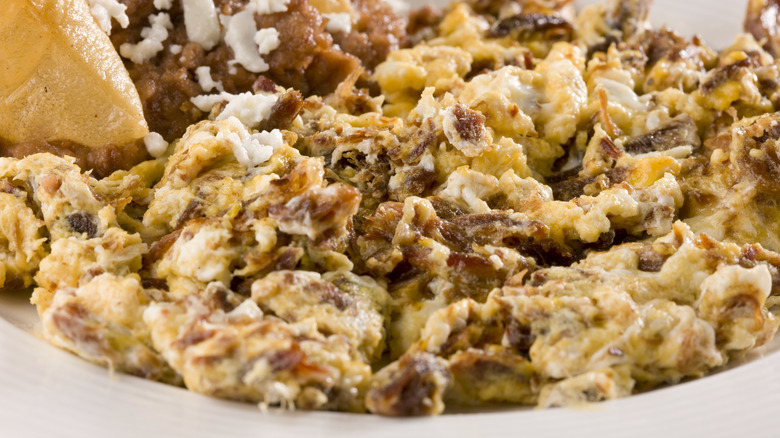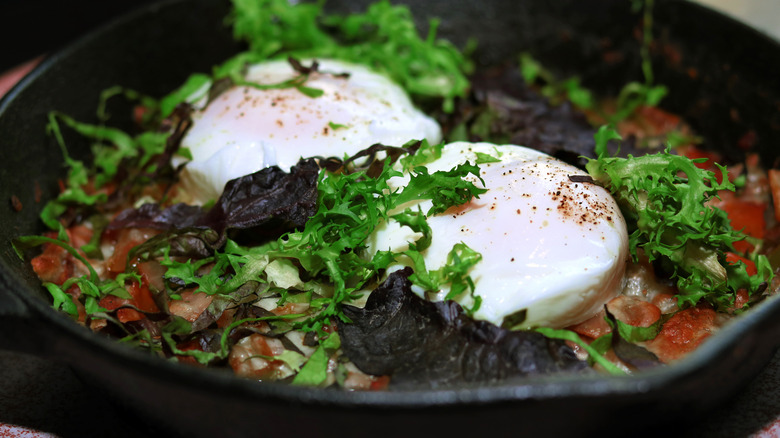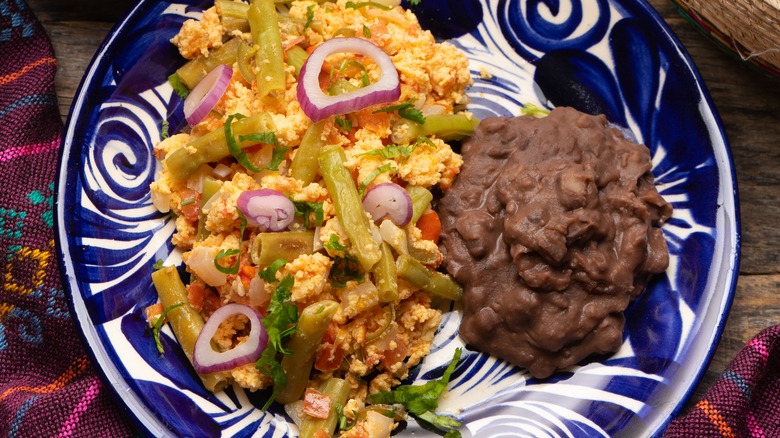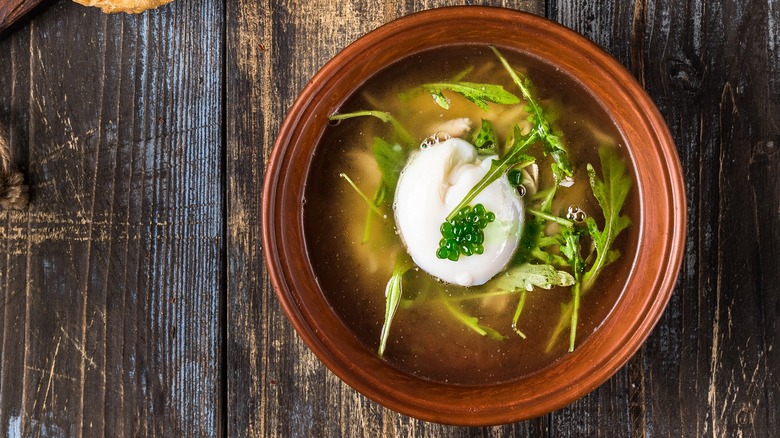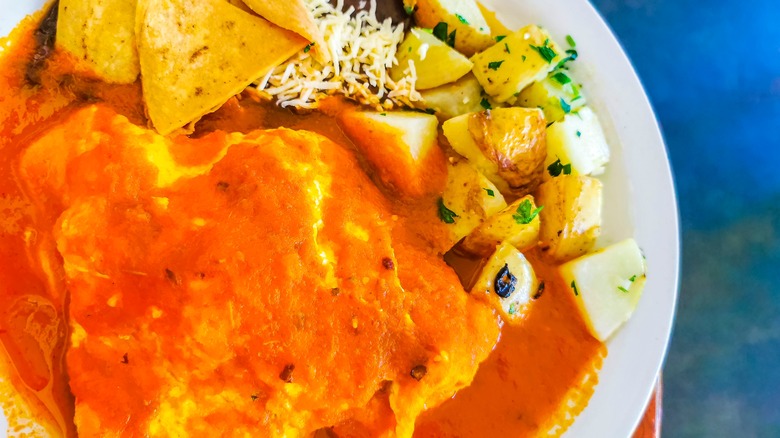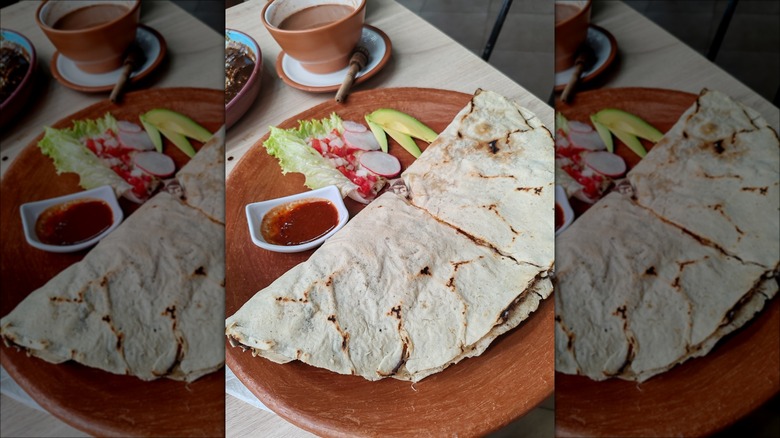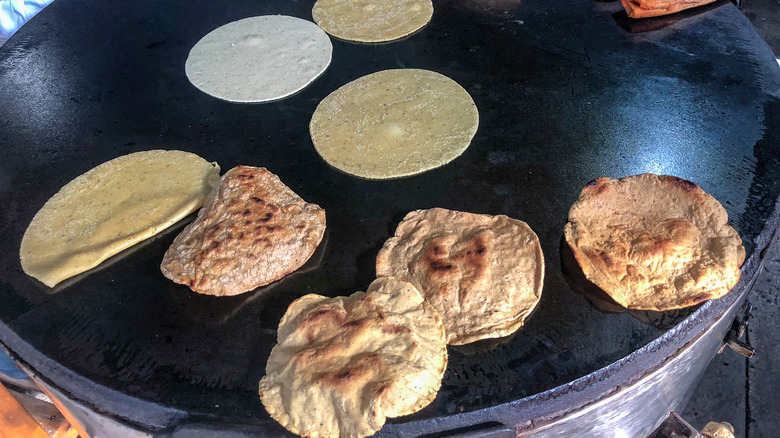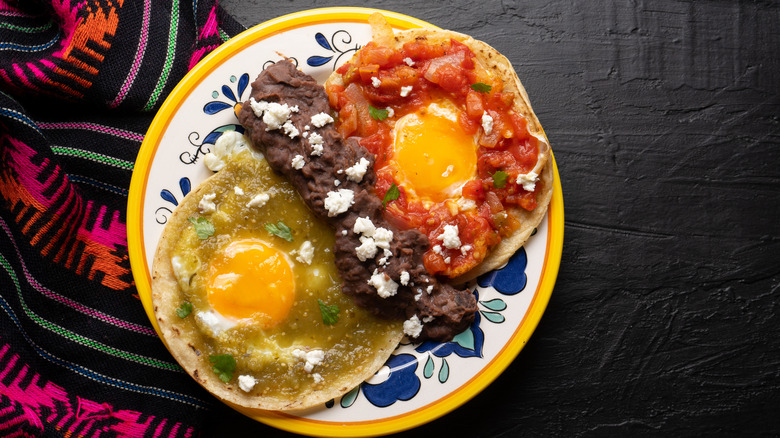14 Egg Dishes From Mexico You Need To Try At Least Once
If someone asked you to name a Mexican egg dish, you'd probably think of huevos rancheros, which loosely consists of fried eggs on corn tortillas with salsa. Or, perhaps a Mexican-inspired breakfast burrito would come to mind, stuffed with eggs, potatoes, cheese, and any other fillings you can imagine. But the fact is, there's way more to Mexican egg dishes than these popular ones.
Dig beneath the surface, and there are dozens of great recipes from Mexico in which eggs play a starring role. From traditional breakfasts like chilaquiles, to homestyle dishes such as sopa de cebolla con huevo, there are options that many people outside of Central America haven't even heard of. And that's a shame, because you're missing out on some delicious dishes.
We spoke to four Mexican chefs and restaurant owners to discover their favorite doishes. They told us what they love about them and the kinds of places that people often eat them, from restaurants to their abuelas' kitchens. These are egg dishes from Mexico you need to try at least once.
Huevos Motuleños
If you like huevos rancheros, but are looking to try something different, you might be interested in huevos motuleños. These two dishes share some common components, such as tortillas and fried eggs, but huevos motuleños have more ingredients and are arguably more interesting.
Iliana de la Vega, owner and chef at El Naranjo in Austin, Texas, is a big fan of this dish. "Huevos motuleños are fried eggs (sunny-side up), on top of a tortilla that has been smeared with a thin layer of black bean paste," she explains. "The eggs are napped with a tomato sauce and Edam cheese sprinkled on top. The dish is served with green peas, cubes of ham, and fried plantains." That's a lot going on and it might seem like the ham, eggs, peas, and plantain wouldn't work together but the flavors manage to sing.
"This dish is originally from Motul, which is a small town in Yucatan," says de la Vega. However, it has since spread across Mexico. It's eaten as a breakfast dish, usually in peoples' homes, although you'll likely find it on some restaurant menus.
Huarache de Asada
This dish is a favorite of Carlos Gaytán, executive chef at Mexican restaurant Paseo in Anaheim. Hugely popular in Mexico, huarache de asada begins with a flatbread made out of masa dough. On top of this, you'll find smashed beans and other ingredients. It's commonly a street food, but it can also be found in restaurants, particularly in the U.S. While it doesn't have to contain eggs, it absolutely can. Fried eggs can be added as a topping, along with salsa, cheese, and more. And, this is how Gaytán makes it.
"My version of the traditional huarache includes a base of corn masa, black bean purée, sautéed spinach, caramelized onion, grilled flank steak, fried egg, and goat cheese fondue," he tells us. "The huarache is a typical Mexican street food, usually topped with beans, salsa, and various proteins. I've added a gourmet touch with the goat cheese fondue and grilled flank steak, transforming it into a luxurious take on a beloved classic."
Chilaquiles
Eggs are just as common a part of the breakfast canon in Mexico as they are in North America. If you're looking for a tasty alternative to huevos rancheros, this might be it. "I love chilaquiles," says José Cepeda, executive chef at Quixote at The Lafayette Hotel and Club in San Diego. In fact, he tells us that it's his favorite breakfast.
But what is it? Cepeda tells us it consists of "tortilla chips, green or red salsa, queso fresco, Mexican cream, onion, and of course huevos al gusto" — which means any style of eggs. The beauty of it is manyfold. Who doesn't want tortilla chips for breakfast? And these are simmered in a salsa, which gives them an excellent texture and flavor. Then, you get to choose the type of eggs you want with it. Perfection. "It's simple magic," Cepeda remarks.
Where should you go if you want to try it? In Mexico, "usually it's easy to find in Mexican places that serve breakfast," says Cepeda. He adds that you may also find it in some modern restaurants. It's less common outside Mexico, but you'll find it on menus in some parts of the U.S. — especially closer to the border. Some people say that fried eggs are the superior choice for chilaquiles, but that's your call to make.
Relleno Negro
A lot of modern Mexican cuisine was influenced by the Spanish invaders. However, there are still some dishes with pre-colonial roots. "Relleno negro is a traditional dish that stands as a gastronomic heritage of the Mayas," says chef Carlos Gaytán. It's a type of stew served with boiled eggs that's traditionally made in November for the festival of Hanal Pixán, which is roughly equivalent to the Day of the Dead.
"It features turkey or chicken cooked in a rich, dark broth made from charred chiles and spices, often served with hard-boiled eggs," Gaytán tells us. "Relleno Negro is a true reflection of the depth and complexity of Mayan cuisine." Gaytán notes that the intense, smoky flavors of this dish come from charred chiles known as recado negro. "The inclusion of hard-boiled eggs in the broth adds a unique texture and richness, making the dish both hearty and satisfying," he adds.
In Gaytán's opinion, relleno negro is more than just a meal. "It's a culinary experience that connects us to the ancient traditions and flavors of the Yucatán Peninsula, reminding us of the rich cultural heritage that continues to influence Mexican cuisine today," he says. It's not the kind of dish you can just find anywhere, so if you ever see it on a menu, don't hesitate to order it.
Tortilla de huevo Española
In the English-speaking world, we have the Spanish omelet, but in Mexico, it's known as tortilla de huevo Española. It's a favorite of Bessie King, owner of Villa Mexico Cafe, who considers it a Mexican food by proxy. "As its name says, it's originally from Spain and when we were colonized the dish came to México," she explains.
"The tortilla de huevo Española is like a quiche with no pie crust, the base is the egg and it's stuffed with vegetables or ham," says King. This is a twist on the classic Spanish tortilla, which only contains potatoes and onions as a filling, so you can see there's a Mexican bent to it. In Mexico, this egg dish is likely seasoned differently, and may contain aromatics that you wouldn't find in the original, such as chiles. And, if you're still wondering the difference between a frittata and a Spanish tortilla, aside from the fillings, it's down to the cooking method. A tortilla is cooked entirely on the stovetop, while a frittata is finished in the oven.
Huevos Tirados
If you're a fan of eggs and beans, huevos tirados should be on your shortlist of must-try Mexican dishes. It's a popular breakfast food in some parts of the country. And one that will keep you going until lunch and beyond, thanks to its double-whammy of protein-rich ingredients.
"Scrambled eggs with refried beans are a specialty of the state of Veracruz," says Iliana de la Vega of El Naranjo, who listed this meal among her favorites. "The dish is traditionally made with lard — quite a healthy amount — and cooked until you can form a log-like shape with the eggs." If you can't picture this, it's a little bit like a messy folded omelet. However, the eggs are scrambled and held together by the beans.
"It's usually served with salsa and corn tortillas," de la Vega tells us. It's also often served with plantains, which bring some sweetness to balance out the rich savory notes of the eggs and beans.
Huevos Rabo de Mestiza
If you like your eggs poached, you might enjoy huevos rabo de mestiza. This is another recommendation from Chef Iliana de la Vega. "This dish is made of poached eggs, cooked directly in a tomato sauce with slices of poblano chiles and julienned onions," she tells us. It's generally served as a breakfast or brunch dish. And, anyone familiar with shakshuka will recognize the vibe. While huevos rabo de mestiza is its own thing and leans into Mexican flavors, those who have mastered a shakshuka recipe probably won't have any trouble learning how to make this.
It's made by charring poblanos, before making a sauce from onions, the charred chilies, canned tomatoes, and various seasonings. This sauce needs to simmer for a while, but once the time is right, the eggs are poached directly in the sauce, infusing them with flavor. It's normally served with queso fresco and corn tortillas. The sauce has rich savory notes, and can be spicy or fairly mild, depending on how hot the poblanos are and how many are used. The runny yolks of the poached eggs add some creaminess to balance the dish.
Huevos a la Mexicana
Both Bessie King of Villa Mexico Cafe and Quixote chef José Cepeda mention huevos a la Mexicana among their favorites. It's a simple yet popular breakfast that basically consists of eggs scrambled in a tomato salsa. It comes together quickly and is popular in homes around Mexico. King tells us it "can be eaten at home or at restaurants where they sell comida corrida." For those not in the know, comida corrida roughly means something like "food on the run" or "food in a hurry." Essentially, these are hole-in-the-wall places selling everyday food by locals, for locals.
But why should you try huevos a la Mexicana? "When it comes to scrambled eggs, huevos a la Mexicana stay in my top three kinds of eggs," Cepeda says. "It is a salsa bandera and scrambled egg combo. Salsa bandera is pretty much the artistic name of pico de gallo, which is mostly an easy-on-the-go kind of breakfast that is also very accessible." He notes that it's a dish usually eaten by adults, because kids may not like the chiles and crunchy raw onions from the pico de gallo. It's nutritionally sound, too. "As a diabetes king myself, this dish contains the right amount of proteins and barely any carbohydrates," notes Cepeda.
Sopa de Cebolla con Huevo
If you're looking for a homestyle dish for a hearty lunch or dinner, sopa de cebolla con huevo might be the thing. The name translates to onion soup with egg, and that pretty much describes it. Bessie King says that it's similar to "French onion soup but with a poached egg," and notes that it's "usually for colder months."
The eggs are poached directly in the soup, which makes it a simple one-pot meal, while also bringing more flavor to the eggs. There are some common mistakes people make with poached eggs, but if you can avoid them, this dish is pretty straightforward to throw together. King says she loves sopa de cebolla con huevo because it's a family staple and is "usually what you eat at home, made by moms."
The addition of eggs instantly makes this dish more filling than an average soup. And, of course, it can be served with bread. Some folks also make it with the addition of melted cheese, like you'd find on a French onion soup. Whatever the details, it's a delicious egg dish worth trying.
Huevo en Salsa
You might assume that huevo en salsa looks something like huevos rancheros, with fried eggs served in a sauce. However, this dish is actually quite different because of the style of eggs. However, it is still a common breakfast dish, and one that's sometimes served with warm tortillas, so there are some similarities to its more popular cousin.
"This is a specialty of Oaxaca's Central Valleys," chef and restaurateur Iliana de la Vega informs us. She says it "consists of beaten eggs cooked flat (think like an omelet), then cut into pieces and heated up in a saucepan filled with a good amount of tomato sauce or green sauce so the eggs will absorb some of the sauce and be juicy and soupy."
It's a little more liquidy than similar recipes, so it may be presented differently. "This dish is traditionally served in a bowl (think soup) with a side of frijoles de la olla [a Mexican bean dish] and freshly made corn tortillas," de la Vega says.
Tlayuda
"Tlayuda is a very versatile and traditional dish from Oaxaca," explains Carlos Gaytán. It's sometimes likened to a kind of Mexican pizza, as it consists of a tortilla topped with various ingredients, including cheese. It can be served open-faced or folded. Eggs aren't necessarily a given, but Gaytán lists it among his favorite egg dishes because he makes his own version.
His tlayuda "features a crispy corn tortilla layered with black bean spread, avocado mousse, fried eggs, cecina, chorizo, pork belly, salsa macha, and Oaxaca cheese." He says that "the addition of eggs, cecina, and salsa macha brings a unique complexity." For those struggling to decipher this list, salsa macha is a type of salsa from Veracruz made using dried chiles, while cecina is a Spanish cured beef.
Tlayuda is worth trying in its own right, but when you see one "con huevo," you should jump at the chance to try it. This dish is a common street food in the Oaxaca region of Mexico, but it's easy enough to recreate at home, too.
Huevos Encamisados
Huevos encamisados is something a bit different from your average egg dish. It's a bit like an egg sandwich made with a tortilla — and it sounds amazing. It's something that egg lovers will be desperate to try at the earliest opportunity.
"This dish is made while you are cooking a corn tortilla in a comal or griddle," says Iliana de la Vega of Austin's El Naranjo. "When the tortilla becomes puffy, or inflates, carefully open the tortilla (separate the top from the bottom layer) and crack an egg inside." It's simple but takes some practice to get right. "This dish can be served with salsa on top or on the side," de la Vega notes.
It's not a hugely popular dish outside of Mexico and its simplicity means that you aren't going to find it at any tourist restaurants. It's often the sort of thing people eat at home, but you might also find it as a street food or at small local eateries around the country.
Huevos al Comal
Quixote's executive chef José Cepeda introduced us to another great Mexican breakfast dish, huevos al comal. Hailing from Oaxaca, it's a popular choice in southern Mexico but may not be readily found elsewhere. It makes use of fresh hoja santa leaves, a Mexican herb with a strong, complex flavor that's sometimes likened to a blend of anise and eucalyptus with peppery notes.
Cepeda says it's great for anyone who wants an alternative Mexican breakfast option. He appreciates the nuanced flavor, including ingredients such as corn, morita chile, and hoja santa. "While you'd find this in southern Mexico restaurants, you'll be lucky enough if you find them in northern Mexico," he says.
But what exactly is huevos al comal? Cepeda explains that it's essentially an egg (and sometimes corn) cooked inside a large hoja santa leaf, served on a tortilla. Cooking the egg inside the leaf imparts some of its complex flavors. According to Cepeda, it's often served with salsa morita, a salsa that isn't spicy but has a pleasant chile flavor. He says it's "not popular yet but it will be — its simplicity is the meaning of greatness."
Huevos Divorciados
Mexican cafe owner Bessie King mentions huevos divorciados as one of her favorite egg-based breakfast dishes. But what is it, and why is this breakfast dish forcing eggs to get a divorce? The name comes from the fact that the dish consists of two eggs, each with its own sauce.
Both eggs are fried, but one is served with a spicy red salsa and the other with a mild green salsa. They're usually served on two separate small tortillas or one large one with refried beans down the center to keep the sauces apart. If you like some variation to your breakfast, this might be a good choice. It's effectively a take on huevos rancheros, but with different sauces.
It's often served with queso fresco, and can have other accompaniments such as fried potatoes or guacamole. It's a fairly common sight in Mexican restaurants that serve breakfast, so it shouldn't be too hard to get your mitts on.
